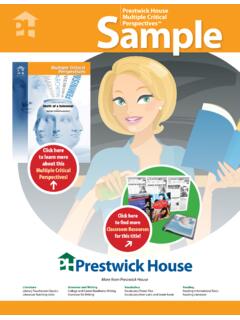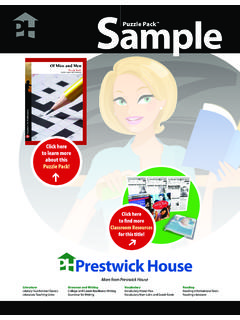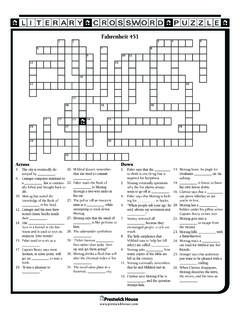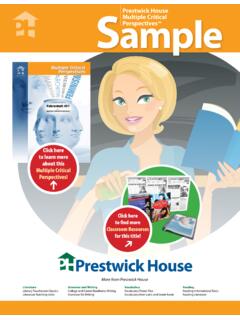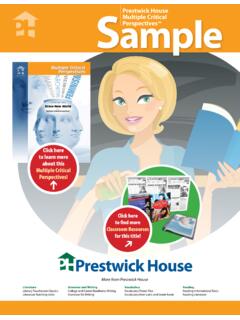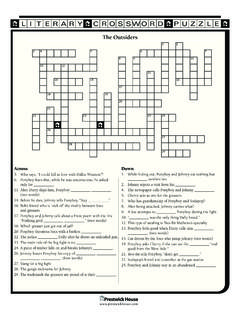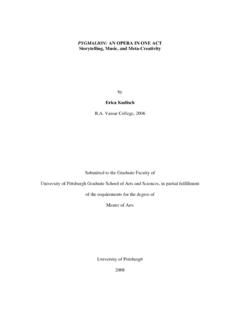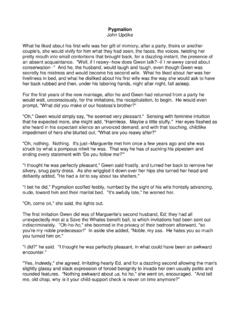Transcription of Teaching George Bernard Shaw's Pygmalion
1 Box 658, Clayton, DE Teaching George Bernard Shaw s from Multiple Critical PerspectivesPygmalion Prestwick HousePrestwick HouseItem No. 308680 Teaching George Bernard Shaw s from Multiple Critical PerspectivesPygmalion Click here to learn more about this Multiple CriticalPerspectives! Click here to find more Classroom Resources for this title! SamplePrestwick HouseMultiple Critical Perspectives LiteratureLiterary Touchstone ClassicsLiterature Teaching UnitsGrammar and WritingCollege and Career Readiness: WritingGrammar for WritingVocabularyVocabulary Power PlusVocabulary from Latin and Greek RootsReadingReading Informational TextsReading LiteratureMore from Prestwick HousePygmalion Teaching George Bernard Shaw's from Multiple Critical Perspectivesby Priscilla Beth BakerMultiple Critical Perspectives 6 PR E S T W I C K HO U S E, IN Critical PerspectivesPygmalionGeneral Introduction to the WorkIntroduction to PygmalionGE O R G E BE R N A R D SH A W W A S A man of strong convictions and opinions, and many of his beliefs are explored in his plays.
2 Pygmalion is no exception. Shaw was a teacher and student of language, a feminist, and a socialist, and all of these aspects are represented in the play. Shaw sees the artist s role as that of a teacher who makes his or her work intensely and deliberately didactic. For those who argue that art should never be didactic, Shaw maintains in the preface to the play that art should never be anything else. Through the characters in Pygmalion , the author creates a vehicle for commenting on phonetics and language and how those ideas are tied to social status. The female characters in Shaw s plays, particularly in Pygmalion , typify Shaw s feminist leanings.
3 Whereas many authors of the time posed women as either victims or decoration, Shaw created vibrant, intelligent, forceful female characters in control of their own destinies, despite the societal constraints of the time period in which he was writing. Deeply infl uenced by his extensive reading of economics and social theory, Shaw became a dedicated socialist supporter. He contended that each of the social classes strove to serve its own ends the upper and middle classes reigned successful in their struggles while the working class perpetually lost due to the greed of their employers, impoverished living conditions, ignorance, and apathy.
4 Students can see evidence of Shaw s socialist leanings in Pygmalion , particularly in the character of Henry Higgins and his attitude towards manners with reference to social equality. The plays of Shaw s time, for the most part, did not portray real people discussing real social problems or ideas. Pygmalion , despite the comedic format, addresses serious issues of class, science, and moral responsibility. Sean O Casey, in his book A Whisper About George Bernard Shaw, writes, Shaw s main fi ght, armed with all his logical art and wit, was to force forward a system of thought that would, in the long or short run, evolve a sane and sensible life for all.
5 He made his plays a forum for considering moral, political and economic issues, possibly his most lasting and important contribution to dramatic E S T W I C K HO U S E, IN C. 13 Multiple Critical PerspectivesPygmalionNotes on the Formalist ApproachTH E F O R M A L I S T A P P R O A C H T O L I T E R A T U R E was developed at the beginning of the 20th century and remained popular until the 1970s, when other literary theories began to gain popularity. Today, formalism is generally regarded as a rigid and inaccessible means of reading literature, used in Ivy League classrooms and as the subject of scorn in rebellious coming-of-age fi lms.
6 It is an approach that is concerned primarily with form, as its name suggests, and thus places the greatest emphasis on how something is said, rather than what is said. Formalists believe that a work is a separate entity not at all dependent upon the author s life or the culture in which the work is created. No paraphrase is used in a formalist examination, and no reader reaction is discussed. Originally, formalism was a new and unique idea. The formalists were called New Critics, and their approach to literature became the standard academic approach. Like classical artists such as da Vinci and Michelangelo, the formalists concentrated more on the form of the art rather than the content.
7 They studied the recurrences, the repetitions, the relationships, and the motifs in a work in order to understand what the work was about. The formalists viewed the tiny details of a work as nothing more than parts of the whole. In the formalist approach, even a lack of form indicates something. Absurdity is in itself a form one used to convey a specifi c meaning (even if the meaning is a lack of meaning). The formalists also looked at smaller parts of a work to understand the meaning. Details like diction, punctuation, and syntax all give TheoryApplied to PygmalionPR E S T W I C K HO U S E, IN C.
8 17 Multiple Critical PerspectivesPygmalionActivity OneExamining the Allusion to the Pygmalion Myth as a Source of Unity1. Copy and distribute Notes on the Formalist Approach and the handout: Pygmalion : Formalist Activity One Graphic Organizer: The Myth of Pygmalion . NOTE: You may want to have students do a short research activity the night before on the Pygmalion myth. A short paragraph summarizing the details of the myth would suffi ce if you have not already discussed this allusion to the Greek myth in Divide the class into pairs or small Have students search for a minimum of four direct or indirect references to the Pygmalion myth and complete the Graphic Organizer.
9 Instruct students to read the text immediately before and after the reference to inform and enhance their explanations. 4. Reconvene the class and discuss the following: Within the context of each occurrence, what does each Pygmalion reference have in common? How is each different? Compare and contrast. Does the recurring symbolism of the Pygmalion myth change throughout the play? If so, in what way(s)? How can the Pygmalion myth be seen as both a literary and a visual motif? How does the Pygmalion myth create tension and confl ict in the play? When does the Pygmalion myth foreshadow future events?
10 How do the allusions to the Pygmalion myth contribute to the play s themes? In what ways does the Pygmalion myth drive the work as a whole? How does the Pygmalion myth serve to unify the work as a whole?PR E S T W I C K HO U S E, IN C. 27 Multiple Critical PerspectivesPygmalionNotes on the Feminist TheoryFE M I N I S M I S A N E V O L V I N G P H I L O S O P H Y, and its application in literature is a relatively new area of study. The basis of the movement, both in literature and society, is that the Western world is fundamentally patriarchal ( , created by men, ruled by men, viewed through the eyes of men, and judged by men).
